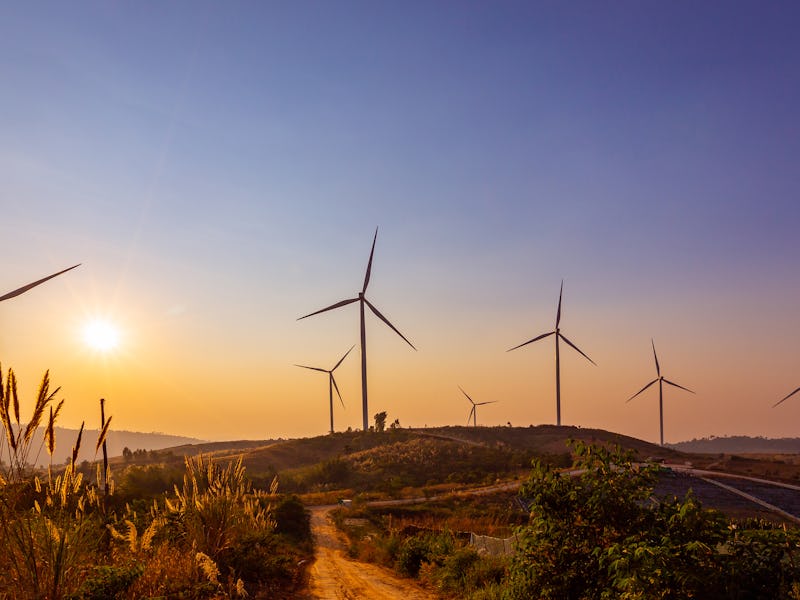How America's wind power could triple by 2030 without using more land
New research looks at how it could be done.

The U.S. currently gets a little under 7 percent of its electricity from wind energy, and the industry is growing. New research shows that number could roughly triple within a decade without taking up any additional land if the right investments are made. According to the IPCC, renewables need to produce 70 to 85 percent of our energy by 2050 to avoid the worst effects of climate change, so that would be a great start.
Researchers at Cornell University claim in a new study published in the journal Scientific Reports that the U.S. could get around 20 percent of its electricity from wind power if it quadruples the number of wind turbines that were installed as of 2014. Sara Pryor, a professor in the Department of Earth and Atmospheric Sciences at Cornell, said in a statement that wind energy is already playing a major role in the fight against climate change.
"Wind energy is already playing a key role in decarbonizing the global energy system," Pryor said. "Wind turbines repay the lifetime carbon emissions associated with their deployment and fabrication in three to seven months of operation and provide nearly 30 years of virtually carbon-free electricity generation."
Getting the U.S. to 20 percent would eliminate 825 million metric tons of carbon dioxide emissions. That's most of the roughly 1,150 million metric tons of carbon dioxide coal burning produces every year and more than the 581 million metric tons that come from burning natural gas.
The land that's already being used for wind farms could be used to install more wind turbines, and the researchers found this would not slow the wind too much. Rebecca Barthelmie, a professor in the Sibley School of Mechanical and Aerospace Engineering at Cornell, said that it would reduce the amount of wind to some degree.
"The 'theft' of wind by upstream wind turbines reduces the overall power produced by the total ensemble of wind turbines and the enhanced mixing (turbulence) can alter local climate conditions close to wind turbines," Barthelmie said.
The researchers also propose updating older wind turbines with new technology so they'll be more efficient and produce more power. This would mean there wouldn't be any more space taken up and therefore there would be no impact on the wind.
As we've previously reported, renewable energy is becoming cheaper than producing electricity using fossil fuels. China is the world's largest producer of greenhouse gases, but the country has been investing heavily into renewables, and it was reported last year that it will double its wind energy capacity by 2025. Not only are more wind turbines popping up, but they're getting bigger. The world's most powerful offshore wind turbine—GE Renewable Energy’s Haliade-X 12 MW—went up in the Netherlands last year, and it's 900 feet tall with blades that are over 300 feet long.
Renewable energy is surely the way of the future, and if the U.S. makes the right investments, it could greatly increase the amount of clean, affordable energy its producing and help fight climate change. That said, it helps to have a president who believes climate change is real and isn't convinced something called "windmill cancer" exists.
Abstract
Impacts from current and future wind turbine (WT) deployments necessary to achieve 20% electricity from wind are analyzed using high resolution numerical simulations over the eastern USA. Theoretical scenarios for future deployments are based on repowering (i.e. replacing with higher capacity WTs) thus avoiding competition for land. Simulations for the contemporary climate and current WT deployments exhibit good agreement with observed electricity generation efficiency (gross capacity factors (CF) from simulations = 45–48%, while net CF for WT installed in 2016 = 42.5%). Under the scenario of quadrupled installed capacity there is a small decrease in system-wide efficiency as indicated by annual mean CF. This difference is approximately equal to that from the two simulation years and may reflect saturation of the wind resource in some areas. WT modify the local near-surface climate in the grid cells where they are deployed. The simulated impact on near-surface climate properties at both the regional and local scales does not increase with increasing WT installed capacity. Climate impacts from WT are modest compared to regional changes induced by historical changes in land cover and to the global temperature perturbation induced by use of coal to generate an equivalent amount of electricity.